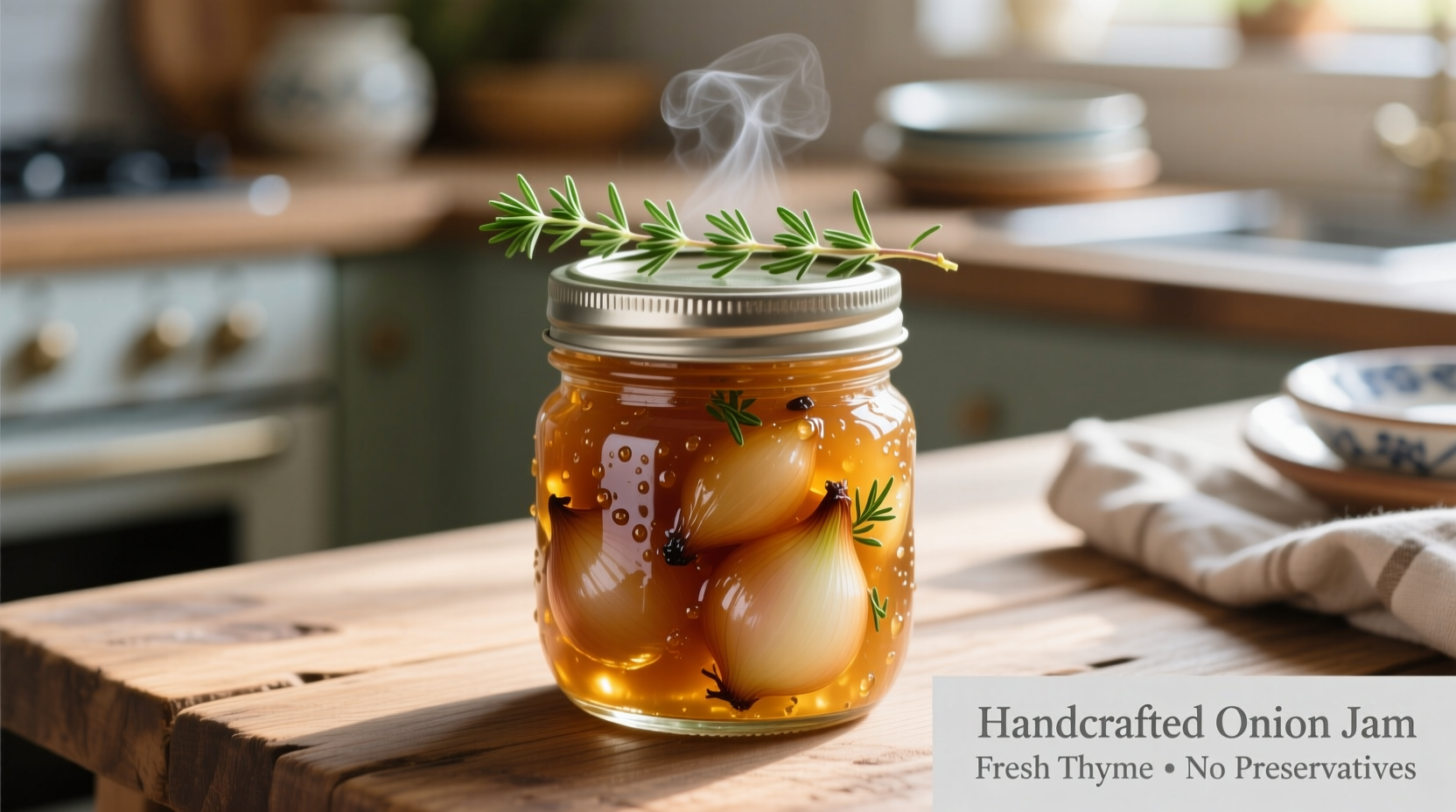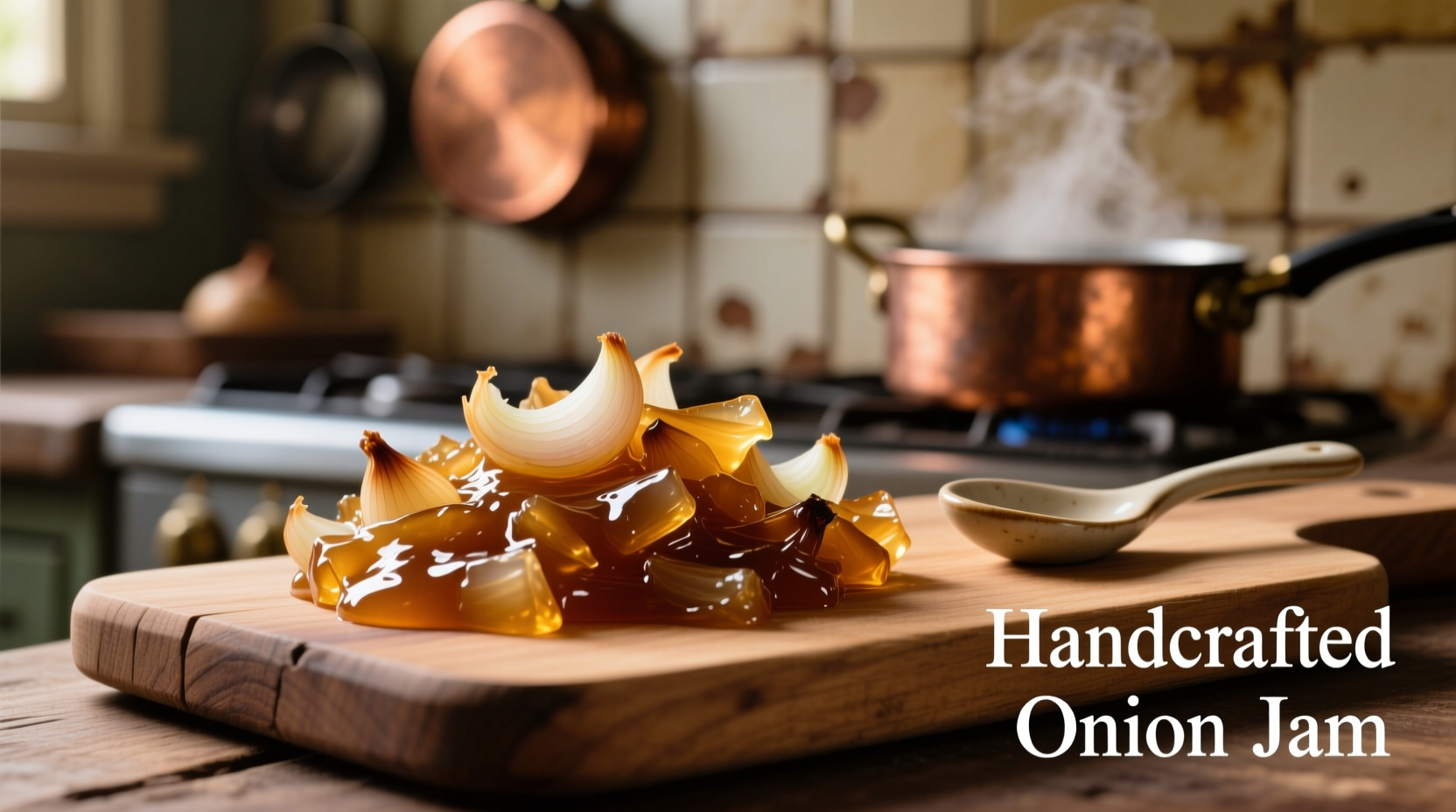Transform ordinary meals into extraordinary culinary experiences with this humble yet powerful condiment that professional chefs keep in their back pockets. Unlike quick caramelized onions, true onion jam achieves a spreadable consistency through careful reduction that concentrates flavors while maintaining structural integrity. Whether you're elevating a simple grilled cheese or adding complexity to roasted meats, onion jam delivers restaurant-quality results with minimal effort.
The Essential Science Behind Perfect Onion Jam
Understanding the Maillard reaction and caramelization process is crucial for creating exceptional onion jam. When onions cook slowly over medium-low heat, their natural sugars break down and recombine, creating hundreds of new flavor compounds. According to food science research from the USDA Agricultural Research Service, this process generates compounds like 2-acetyl-1-pyrroline that provide the characteristic savory-sweet aroma of properly cooked onions.
| Preparation Method | Cooking Time | Texture | Best Uses |
|---|---|---|---|
| Quick Caramelized Onions | 15-20 minutes | Moist, separate strands | Pizza topping, burger garnish |
| Onion Marmalade | 30-40 minutes | Chunky, jam-like | Cheese boards, charcuterie |
| Traditional Onion Jam | 45-60 minutes | Smooth, spreadable | Sandwiches, glazes, dips |
Building Flavor Foundations: Ingredients That Matter
The magic of onion jam lies in its simplicity—typically requiring just onions, sweetener, acid, and salt—but each component plays a critical role. Yellow onions provide the ideal balance of sweetness and pungency, while red onions add visual appeal and slightly fruitier notes. For sweeteners, light brown sugar contributes molasses depth that white sugar lacks, though maple syrup offers an excellent vegan alternative with complementary earthy notes.
Vinegar selection dramatically impacts final flavor: apple cider vinegar provides fruity acidity, sherry vinegar adds nutty complexity, and balsamic delivers rich sweetness. The U.S. Food Safety and Inspection Service recommends maintaining a minimum 3% acidity level in preserves for safe storage, which translates to approximately 1/4 cup vinegar per 4 cups of sliced onions.

Step-by-Step Cooking Process: From Raw Onions to Culinary Gold
Begin by thinly slicing 4 cups of onions (about 3 medium) using a mandoline for consistent thickness. Cook them slowly in 2 tablespoons of olive oil over medium-low heat, stirring occasionally. The critical phase occurs between 20-35 minutes when onions transition from translucent to golden—this is where patience pays off. Rushing this stage by increasing heat creates uneven browning and bitter notes.
After 35 minutes, when onions have reduced by half and turned deep gold, add 1/4 cup sweetener, 1/4 cup vinegar, and 1 teaspoon salt. Continue cooking 15-20 minutes until the mixture holds its shape when spooned but flows slowly. The perfect consistency resembles thick peanut butter—spreadable but not runny. Remove from heat and stir in optional flavor enhancers like fresh thyme or a pinch of red pepper flakes.
Culinary Applications That Showcase Onion Jam's Versatility
Move beyond basic sandwich spreading with these professional applications:
- Meat Glaze: Brush onto pork chops during final 5 minutes of cooking
- Cheese Enhancement: Spread thinly on brie before baking
- Breakfast Upgrade: Swirl into scrambled eggs or omelets
- Vegetarian Boost: Layer in mushroom burgers for umami depth
- Cocktail Mixer: Dissolve in warm broth for instant French onion soup
When pairing with cheeses, follow this professional guideline: match intensity levels. Mild cheeses like havarti pair beautifully with standard onion jam, while robust blues and aged cheddars benefit from versions enhanced with balsamic vinegar or smoked paprika.
Storage Guidelines and Shelf Life Management
Properly stored onion jam maintains quality for 2 weeks in the refrigerator or up to 6 months frozen. Transfer to clean glass jars while still warm, leaving 1/2 inch headspace. The National Center for Home Food Preservation confirms that the combination of sugar, acid, and cooking time creates an environment inhospitable to harmful bacteria, though mold may develop on improperly stored batches.
For extended storage, freeze in ice cube trays then transfer cubes to freezer bags—this portioning method allows precise usage without thawing entire batches. Always use clean utensils when serving to prevent contamination.
Troubleshooting Common Onion Jam Challenges
Even experienced cooks encounter issues. If your jam seems too watery after cooking, return to heat for 5-10 minutes to evaporate excess moisture. For overly dark results, reduce heat during the initial caramelization phase—onions should take at least 30 minutes to reach golden stage. When flavor balance feels off, adjust with small increments of salt (to enhance), vinegar (to brighten), or sweetener (to mellow).
Professional chefs often employ the "taste-as-you-go" method: after adding vinegar and sweetener, let the mixture cook 5 minutes, then taste and adjust before continuing. This iterative approach prevents overcorrection that can't be undone.
Advanced Techniques for Flavor Elevation
Take your onion jam from good to exceptional with these chef-approved enhancements:
- Add 1 tablespoon of tomato paste during caramelization for deeper color and umami
- Infuse cooking oil with fresh herbs before adding onions
- Finish with a splash of high-quality sherry or port wine
- Incorporate roasted garlic during the final 10 minutes of cooking
- Use a combination of onion varieties (yellow, red, sweet Vidalia) for complex flavor
For special occasions, create a luxurious version by substituting 1/4 cup of the vinegar with champagne and adding a pinch of saffron threads during the final cooking phase. This variation pairs exceptionally well with poultry and seafood dishes.
Frequently Asked Questions
Can I make onion jam without sugar?
Yes, though the texture and preservation qualities will differ. Onions contain natural sugars that caramelize during cooking, but without added sweetener, the jam will be thinner and more acidic. For sugar-free versions, increase cooking time by 10-15 minutes to achieve proper thickness and balance acidity with a pinch of baking soda (1/16 teaspoon per cup of onions).
Why does my onion jam taste bitter?
Bitterness typically results from cooking onions too quickly at high heat, causing uneven caramelization and burnt spots. To fix bitter jam, add 1-2 teaspoons of honey or maple syrup and a splash of vinegar, then cook for 5 additional minutes. For future batches, maintain medium-low heat and stir regularly during the initial 30 minutes of cooking.
How can I use onion jam in vegetarian cooking?
Onion jam adds crucial umami depth to vegetarian dishes that often lack meat-based flavors. Spread on portobello mushrooms before grilling, mix into lentil patties, swirl into vegetarian gravy, or use as a pizza base instead of tomato sauce. It's particularly effective in mimicking the savory notes of bacon in vegan breakfast dishes.
What's the difference between onion jam and French onion soup?
While both start with caramelized onions, French onion soup is a broth-based preparation with wine and beef stock, typically served hot with toasted bread and melted cheese. Onion jam is a concentrated preserve with higher sugar content and thicker consistency, designed for spreading or as a flavor enhancer rather than a standalone soup. You can transform onion jam into instant French onion soup by dissolving 2 tablespoons in 1 cup of hot beef or vegetable broth.
Can I double the recipe for larger batches?
Yes, but avoid simply doubling all ingredients in one pan. Instead, cook onions in separate batches to prevent overcrowding, which steams rather than caramelizes them. Use a wider pan rather than deeper one when scaling up. Note that cooking time increases disproportionately with larger quantities—expect 75-90 minutes for an 8-cup batch rather than the expected 60 minutes.











 浙公网安备
33010002000092号
浙公网安备
33010002000092号 浙B2-20120091-4
浙B2-20120091-4